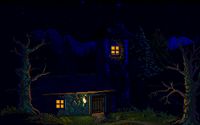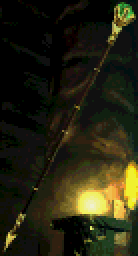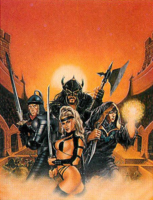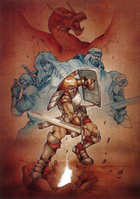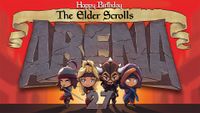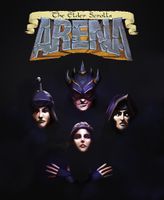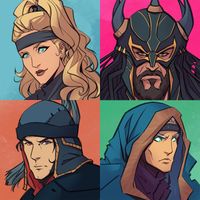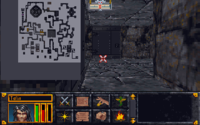Lore:Eternal Champion
| Eternal Champion | |||
|---|---|---|---|
| Race | Unknown[nb 1] | Gender | Unknown[nb 1] |
| Born | 3E 370 |
||
| Resided in | Imperial Province | ||
| Appears in | Arena | ||
The Eternal Champion, purportedly named Talin,[1][nb 1] (b. 3E 370)[2] was an otherwise unknown hero best known for ending the Imperial Simulacrum in 3E 399 by bringing together the pieces of the Staff of Chaos, killing the impostor emperor Jagar Tharn,[3] and rescuing the true emperor, Uriel Septim VII, and general of the Imperial Guard, Talin Warhaft,[nb 2] from a dimension of Tharn's choosing where they had been imprisoned for ten years.[4][5]
History[edit]
Early Life[edit]
The Champion's father, General Talin Warhaft, fought in a battle at Borim Valley, and they had a great-aunt and a great-uncle who each lived in separate villages close to the Champion's home village. During their childhood, the Champion worked at the stables of their home village and was taught how to fight by Armsmaster Festil, an elderly warrior.[6] They became friends with Ria Silmane after they were summoned to the Imperial Court to learn under her tutelage the ways of sorcery.[1] At the Imperial Court they were considered only a minor member of no real consequence.[7]
Alternate Backstories[edit]
Outside of the purported background of the Eternal Champion as Talin, various cultures throughout Tamriel have conflicting claims about the hero. Supposed identities for the Champion include Grachta the Redguard Knight, Dunastyr the Breton Sorcerer, Shathra the female Ohmes Khajiti Assassin, and Tyronicus the Cyrodilic Battlemage.[UOL 1] Other unnamed identities include the Altmer account who claim in public the Champion was an enlightened wizard, but in private admit he was an outcast. The Nords see them as the son of a proud king. The Dunmer have legends that they were the daughter of the living goddess Almalexia. The Bosmer say she was an Ayleidion Aurehliar. Even some vampire clans have their own legends for the Eternal Champion, with the Lysrezi believing him to be a vampire from a realm outside of Nirn.[UOL 2]
Imperial Simulacrum[edit]
In 3E 389, Jagar Tharn overthrew Emperor Uriel, imprisoned him and General Warhaft in Oblivion, and killed Ria Silmane. The Champion was imprisoned by Jagar Tharn in the Imperial Dungeons and left to die. Using what little of her life force remained, Silmane contacted the Champion from between the mortal world and the afterlife and guided them to freedom through a shift-gate, tasking them with reassembling the Staff of Chaos and rescuing the emperor.[8][nb 3] Silmane aided the Champion in this task by using her magic to mask the Champion's identity,[7] which successfully concealed the Champion's name from Tharn until seven of the Staff's eight pieces had been recovered.[9]
Using Silmane's guidance to find the location of the pieces, with covert assistance from Queen Barenziah and King Eadwyre, who through contact with Silmane gathered intelligence on the locations of the pieces of the Staff of Chaos to be passed on to the Champion,[8] the Champion journeyed to Stonekeep, Fang Lair, the Fortress of Ice, Labyrinthian, Selene's Web, the Elden Grove, the Temple of Agamanus, the Halls of Colossus, the Temple of Mad God, the Crystal Tower, the Mines of Khuras, the Crypt of Hearts, the Vaults of Gemin, Murkwood, Black Gate, and Red Mountain on a quest that spanned the course of a decade, before ultimately descending into the depths of the Imperial Palace to face Tharn. The Champion defeated Tharn in 3E 399, with their battle doing considerable damage to the Imperial Palace,[10] by draining the Jewel of Fire of its power and restoring the Staff of Chaos to its full power, killing Tharn in the process. The Champion then freed Emperor Uriel and General Warhaft from Oblivion and was proclaimed by the Emperor as the Eternal Champion. They then took their place at the emperor's side, tasked with seeing to the needs of the Empire.[11]
Legacy[edit]
The Eternal Champion became somewhat of a cultural hero to Imperial Loyalists, many of whom retracing their steps as part of a pilgrimage.[12] Some remember them as one of the greatest warriors in the modern eras.[3] Their identity remained unknown to the public for years after their quest's completion,[3][13] which some claimed was at the will of Emperor Uriel Septim VII.[UOL 3]
Gallery[edit]
Notes[edit]
- The name, race, and gender of the Eternal Champion is ultimately player determined. The introduction to the official game manual refers to them as a male named Talin.[1] Additionally, a pre-release screenshot depicts the Eternal Champion as a Breton male named Talin.[nb 4] Some books refer to the Champion as male.[8][14] Alternate backstories were provided in unofficial lore.
- In the original release of Arena, General Warhaft is shown leaving Oblivion with Uriel VII, and thanks the Champion for their service. In the Deluxe Edition, Uriel VII alone is seen leaving Oblivion, with no mention of Warhaft whatsoever.
- The events of Arena start in 3E 389, however, according to the Biography of Queen Barenziah, this happened after the death of Symmachus, which occurred in 3E 391.[2]
- In Daggerfall, a background history would have been used for a cut feature allowing players to import their character from Arena which would have made the Agent and the Eternal Champion one and the same.[UOL 4]
References[edit]
- ^ a b c d Arena Player's Guide
- ^ a b The Daggerfall Chronicles — Ronald Wartow
- ^ a b c Hallgerd's Tale — Tavi Dromio
- ^ Arena introduction scene
- ^ The Third Era Timeline — Jaspus Ignateous
- ^ Arena character creation scenario
- ^ a b Ria Silmane's dialogue in Arena
- ^ a b c Biography of Barenziah, v 3 — Stern Gamboge, Imperial Scribe
- ^ Jagar Tharn's dialogue in Arena
- ^ Imperial Palace Guard's dialogue in Arena
- ^ Events of The Imperial Palace in Arena
- ^ A Minor Maze
- ^ Brief History of the Empire v 4 — Stronach k'Thojj III
- ^ The Real Barenziah, v 5 — Anonymous
Note: The following references are considered to be unofficial sources. They are included to round off this article and may not be authoritative or conclusive.
| |||||||||||||
